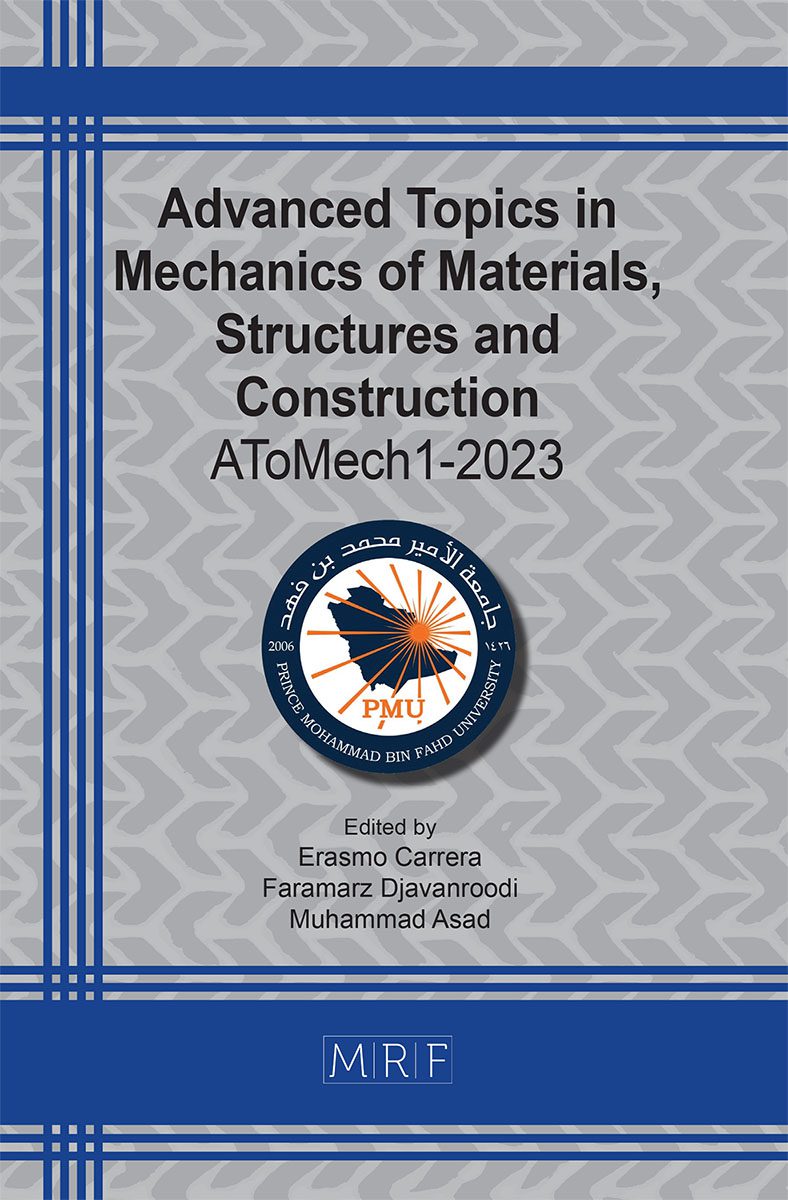Bi-axial behavior of glass/epoxy pipe subjected to internal pressure
Abdul Mateen Mohammed, Tajuddin Mohammed, Ravi Shankar D.V., Manzoor Hussain M., Puneetha
download PDFAbstract. Composite structures are considered as the auxiliary to the conventional metallic materials. However, a thorough understanding of the material behaviour is required to replace the materials in use with scientific evidence for design rather than the designing based on high safety factor. The behaviour of filament wound E-glass/epoxy pipes of different helix angles exposed to internal pressure are studied. The sample GFRP pipe of different helix angles namely [±45o], [±55o] & [±70o] were subjected to open end pressure until the sample failed due to burst(pressure) and the corresponding strains were recorded using the strain smart 5000 data acquisition system (DAQ). The theoretical first-ply failure and burst pressure were determined using (i) Maximum stress theory, (ii) Maximum strain theory and (iii) Tsai Hill theory and were later compared with the experimental results. The first ply failure of the samples was observed by the whitening phenomenon. Later, the damage initiated by the formation of pine holes that act as a micro crack and which later grows to a macro crack in the fiber direction until final failure. A nonlinear relation between the longitudinal stress and strain was observed.
Keywords
Open End Burst Test, GFRP, Bi-Axial Behaviour, Stress and Strain
Published online 8/10/2023, 9 pages
Copyright © 2023 by the author(s)
Published under license by Materials Research Forum LLC., Millersville PA, USA
Citation: Abdul Mateen Mohammed, Tajuddin Mohammed, Ravi Shankar D.V., Manzoor Hussain M., Puneetha, Bi-axial behavior of glass/epoxy pipe subjected to internal pressure, Materials Research Proceedings, Vol. 31, pp 466-474, 2023
DOI: https://doi.org/10.21741/9781644902592-48
The article was published as article 48 of the book Advanced Topics in Mechanics of Materials, Structures and Construction
![]() Content from this work may be used under the terms of the Creative Commons Attribution 3.0 license. Any further distribution of this work must maintain attribution to the author(s) and the title of the work, journal citation and DOI.
Content from this work may be used under the terms of the Creative Commons Attribution 3.0 license. Any further distribution of this work must maintain attribution to the author(s) and the title of the work, journal citation and DOI.
References
[1] P. A. Zinoviev, S. V. Tsvetkov, Mechanical properties of unidirectional organic-fiber reinforced plastics under hydrostatic pressure, Composites Science and Technology 58 (1998) 31-9. https://doi.org/10.1016/S0266-3538(97)00079-1
[2] DNVGL-RP-F119, Recommended Practice for Thermoplastic composite pipes, Technical Report, DNV GL, 2015.
[3] R. Rafiee, F. Reshadi, Simulation of functional failure in GRP mortar pipes, Compos. Struct. 113 (2014) 155-163. https://doi.org/10.1016/j.compstruct.2014.03.024
[4] P. Mertiny, A. Gold, Quantification of leakage damage in high-pressure fibre reinforced polymer composite tubular vessels, Polym. Test. 26 (2) (2007) 172-179. https://doi.org/10.1016/j.polymertesting.2006.09.009
[5] Rosenow MWK. Winding angle effects in glass fibre reinforced polyester filament wound pipes. Composites 1984;15(2):144-52. https://doi.org/10.1016/0010-4361(84)90727-4
[6] Spencer B, Hull D. Effect of winding angle on the failure of filament wound pipes. Composites 1978:263- 71. https://doi.org/10.1016/0010-4361(78)90180-5
[7] Arikan H. Failure analysis of (±55_) filament wound composite pipes with an inclined surface crack under static internal pressure. Compo Struct 2010;92 (1):182-7. https://doi.org/10.1016/j.compstruct.2009.07.027
[8] H.F. Schwencke, The use of the ultimate elastic wall stress (UEWS) in evaluating PVC polymer blends, J. Vinyl Technol. 11 (1) (1989) 28-32. https://doi.org/10.1002/vnl.730110108
[9] H. Faria, R.M. Guedes, Long-term behaviour of GFRP pipes: reducing the prediction test duration, Polym. Test. 29 (3) (2010) 337-345. https://doi.org/10.1016/j.polymertesting.2009.12.008
[10] T.A. Assaleh, L.A. Almagguz, Ultimate elastic wall stress (UEWS) test under biaxial loading for glass-fibre reinforced epoxy (GRE) pipes, Adv. Mater. Res. 974 (2014) 188-194. https://doi.org/10.4028/www.scientific.net/AMR.974.188
[11] M.S. Abdul Majid, M. Afendi, R. Daud, N.A.M. Amin, A. Mohamad, E.M. Cheng, M. Hekman, General lifetime damage model for glass fibre reinforced epoxy (GRE) composite pipes under multiaxial loading, Key Eng. Mater. 594 (2014) 624-628. https://doi.org/10.4028/www.scientific.net/KEM.594-595.624
[12] M.S. Abdul Majid, A.G. Gibson, M. Hekman, M. Afendi, N.A.M. Amin, Strain response and damage modelling of glass/epoxy pipes under various stress ratios. Plastics, (2014) 290- Rubber and Composites, 299. https://doi.org/10.1179/1743289814Y.0000000101
[13] M.S. Abdul Majid, M. Afendi, R. Daud, A.G. Gibson, T.A. Assaleh, J.M. Hale, M. Hekman, Acoustic emission monitoring of multiaxial ultimate elastic wall stress tests of glass fibre-reinforced epoxy composite pipes, Adv. Compos. Mater. (2014) 1-17. https://doi.org/10.1080/09243046.2013.871175
[14] M.S. Abdul Majid, M. Afendi, R. Daud, A.G. Gibson, M. Hekman, Effects of winding angles in biaxial ultimate elastic wall stress (UEWS) tests of glass fibre reinforced epoxy (GRE) composite pipes, Adv. Mater. Res. 795 (2013) 424-428. https://doi.org/10.4028/www.scientific.net/AMR.795.424
[15] M.S. Abdul Majid, T.A. Assaleh, A.G. Gibson, J.M. Hale, A. Fahrer, C.A.P. Rookus, M. Hekman, Ultimate elastic wall stress (UEWS) test of glass fibre reinforced epoxy (GRE) pipe, Compos. A: Appl. Sci. Manuf. 42 (10) (2011) 1500-1508. https://doi.org/10.1016/j.compositesa.2011.07.001
[16] Qi Guoquan1, Qi Dongtao1, Bai Qiang1, Li Houbu1, Wei Bin1, Ding Nan1, Zhang Dongna1, and Shao Xiaodong, Failure Analysis on Pressure Leakage of FRP, Fibers and Polymers 2019, Vol.20, No.3, 595-60. https://doi.org/10.1007/s12221-019-8617-5































